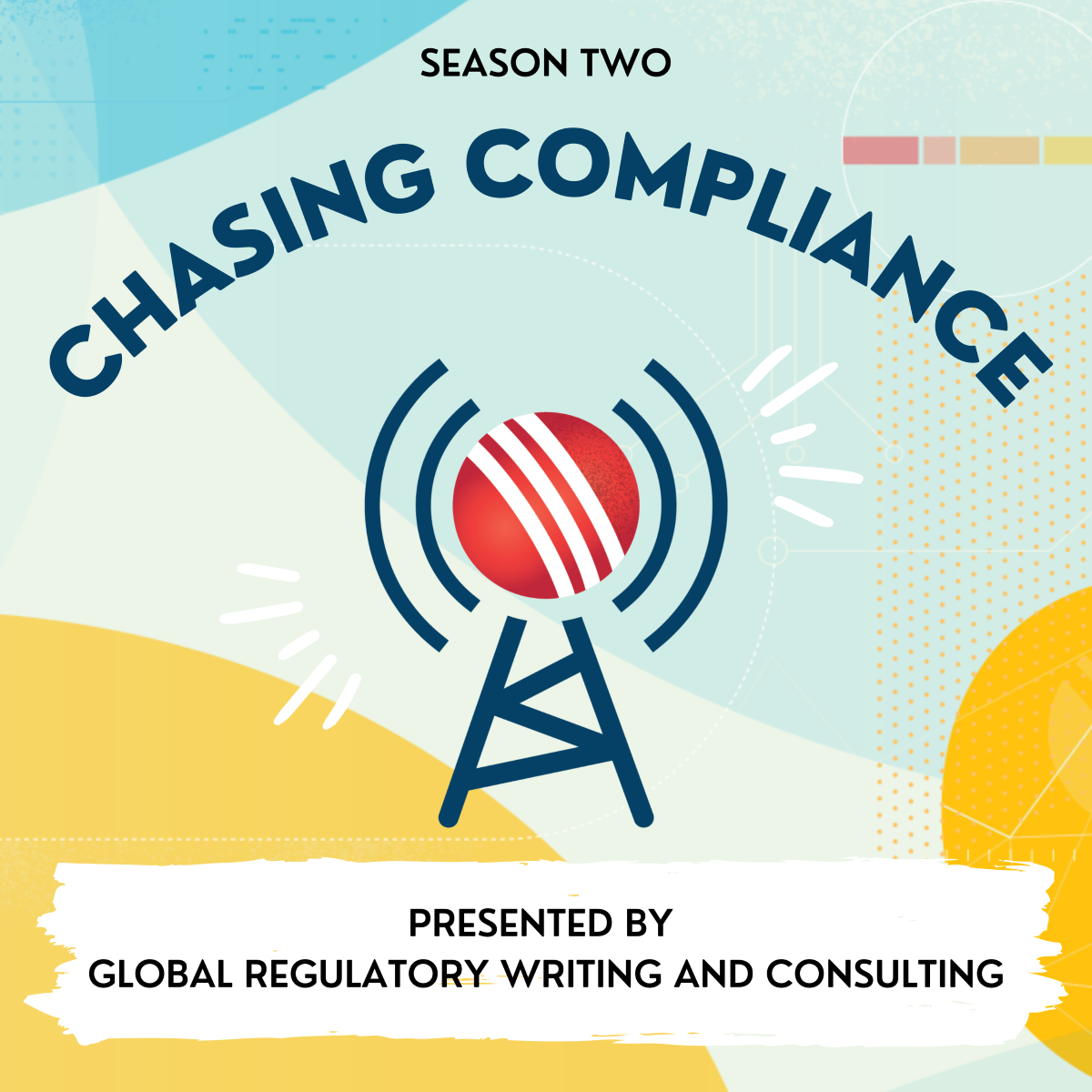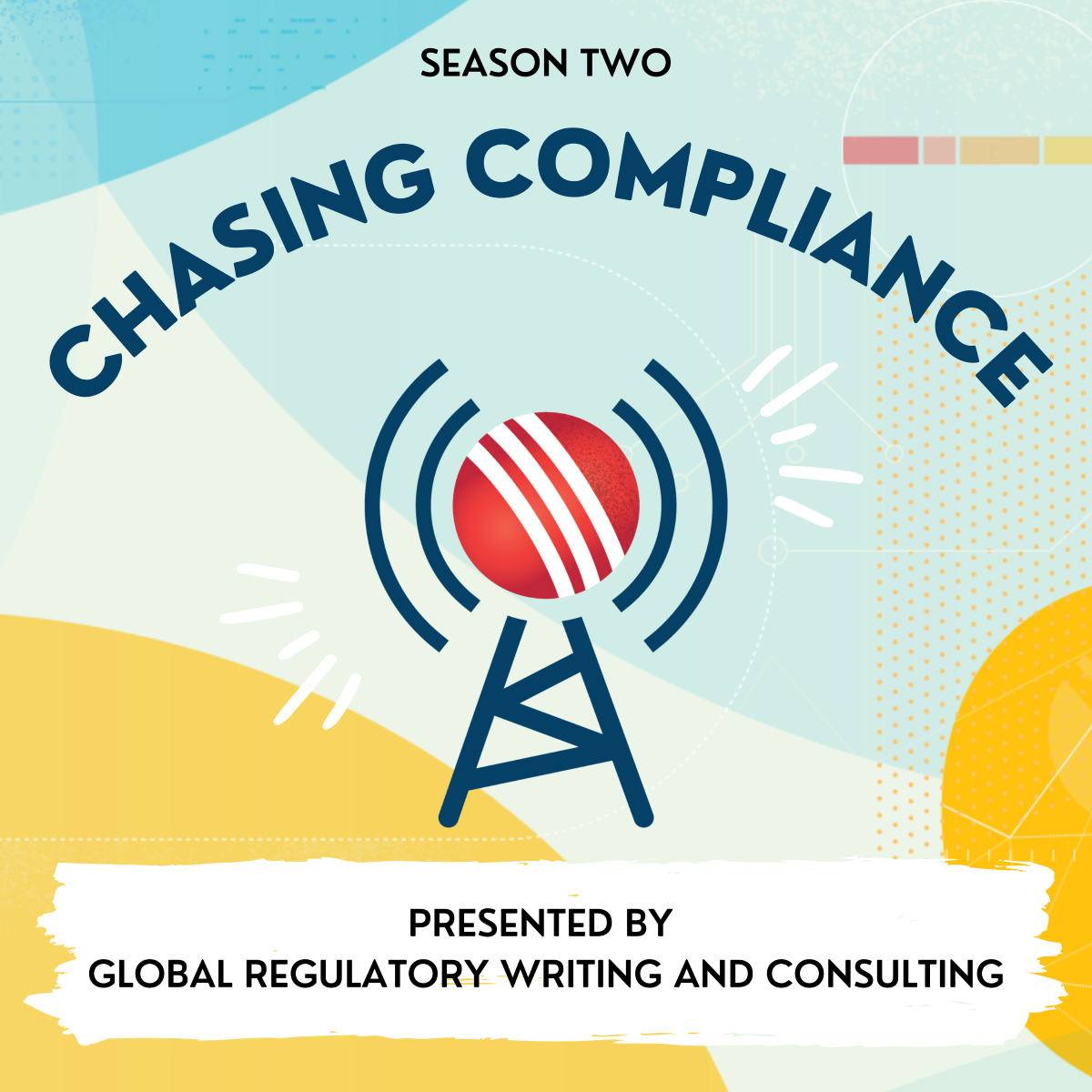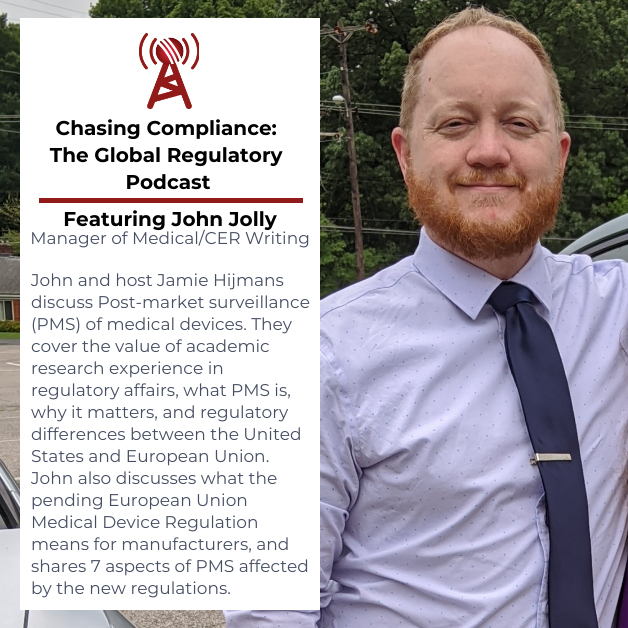00:00:03 Speaker 1
Welcome to Chasing Compliance, the Global Regulatory Podcast where we discuss all aspects of medical, device and pharmaceutical regulatory and clinical strategy from bench to bedside. Today we are chatting with Eimile Oakes and Andrew Stephens. Eimile Oakes is a senior manager of the medical writing team at Global, where she leads a team of writers delivering high quality clinical and regulatory documents for biotech and pharmaceutical clients. With a PhD in molecular biology and over a decade of experience in scientific communication, she specializes in translating complex data into clear, compliant documentation that supports successful regulatory submissions. Andrew Stephens is a senior medical writer who has been in the industry for 12 years. He primarily writes clinical and regulatory documents such as Clinical Study Reports and protocols for pharmaceutical clients, and he previously worked on clinical evaluation reports for medical device clients. Thank you both for being here on this episode. We are discussing clinical study reports, also known as CSRS. CSRS must tell a clear compliance incredible story of a clinical trial with so many moving parts and often tight timelines. Getting it right requires expertise, and I'm sure our audience is looking forward to your insights around CSRS, so let's dive in.
So to start us off, what are the top two to three things that you would tell a new medical writer to keep in mind when approaching a CSR?
00:01:32 Speaker 2
All right. Thanks Rachael. Thanks for having me on. So I say the first thing is to understand the regulatory framework, especially ICH E3. So ICH E3 is kind of like the blueprint of your CSR and it tells you what goes where and what needs to be included. And so your reviewers expect to find certain information in very specific places, so following the structure of ICH E3 not only keeps your CSR compliant, but it also makes your reviewer's job a lot easier because they can quickly find what they're looking for and it builds their confidence and in the report that you're writing, the second thing I would tell new medical writer is to really focus on traceability and consistency. So CSR has several key input documents, including the protocol, the statistical analysis Plan, or the SAP and the TFL's, and so it's important when you're writing your CSR make sure that not only the data is consistent between those inputs and your report, but also your terminology and your conclusions need to be all aligned. And finally, I would say another thing to stress is objectivity. So when you're writing a CSR, you aren't doing a sales pitch. What you're trying to do is communicate the facts in a clear and transparent way. So you want to explain the key design choices that were made in the study and also the results without bias and in a way that's supported by your data. So the medical writers role is to tell the story of the study, why it was designed the way it was, what happened during the study execution and then what the results showed. While keeping the tone factual, so when you kind of combine this objectivity with a narrative or a story, the report is really trustworthy and easy to follow for the reviewer.
00:03:28 Speaker 1
Yeah, Emile. Thank you. That's…I love that. It's really easy to follow, easy to understand, traceability, consistency, objectivity, all things I think medical writers are already great at and can definitely implement into a CSR. Andrew, what about you? What would you tell a new writer?
00:03:44 Speaker 3
I'd say, you know, after considering everything, Eimile said kind of to set the stage. The next step is to get your ducks in a row and that's to get all of the inputs you're going to need for, you know to begin writing, so I find a very good place to start this, you know, make a checklist is to go to the table of contents for the ICH E3 guidelines and just kind of go through section by section and see what you're going to need? To complete that section, and that includes the appendices that's often overlooked. It's down there, you know, and section 16, I think. And so it's, it's these other things that are that are kind of a hassle to gather, but it's good to get them ahead of time, get it all together when you start so that you can. So you can write and not have any surprises and at the very least have some clear timelines with the client about when you're going to get these inputs to make sure that that you've got time to incorporate them. If there are some things that are lagging.
00:04:51 Speaker 1
That's absolutely great advice, especially those very key details and those little nuances that are so important to the entire document that, like you say, can sometimes be forgotten. So great to have that up front, ready to go. Love it. So there are a few different types of CSRS. Full, supplemental, abbreviated, synoptic. What have you found to be similar, and what differences stand out in preparing these different documents?
00:05:16 Speaker 3
Yeah, that's a great question. That's kind of fundamental to writing CSR's. You know the full, the full CSR, that's what you see most commonly and that's what the ICH guidelines are written to address. And so that's, you know, the full exhaustive detail, full appendices and it's the most demanding for the for the study team, for, for coordinating with them, to get everything done. But this is going to have all your efficacy data, all your safety data, everything you've learned about this study and from there, it's really just kind of stepping back in, in levels of detail. Where abbreviated CSRS are a little more streamlined. Usually these are early phase trials, you know, phase one non pivotal or if a trial terminated early but you still need to meet the minimum regulatory content requirements. So these I believe FDA put out some guidance on sections that. That it view, you know it, it sees that should be included. So you're gonna have the full safety right up just like you would in a full CSR. But you're not necessarily going to have efficacy, you're going to have more abbreviated patient information. So. So those, those are those are the ones you see the most full and abbreviated and then you've got synoptic reports which are even more concise than the abbreviated and for similar purpose with early phase or early terminated trials. Think - What I have seen is a lot of clients prefer to go with the abbreviated rather than a synoptic just in case because you need to put in enough information about, you know, the trial structure so that the reviewers can say OK, well, maybe we need more information. Maybe you need to give us the abbreviated. So I think a lot of a lot of clients just decide to go with you abbreviated just to be safe. And then the final categories, the supplemental CSS. Here and this is to provide relevant safety or efficacy results from you know, cross study analysis or unplanned analysis that were not in the completed full CSR. So if you know you had your reporting requirement and you needed to file your CSR you. You do it, but then you come back. You have the supplemental CSR that can even just reference back to that full CSR and provide the more comprehensive information. So. Those are the main categories that of CSRS that you'll run into.
00:08:16 Speaker 1
Thank you for that breakdown and that makes a lot of sense around what is needed based on the clients’ needs and the details within the document. And that's so important when we're working with clients to ensure that we're meeting their needs and getting what they're looking for out of the partnership. And we know that establishing stakeholders before any project is critical to ensure smooth project management across the board. So when approaching a CSR, which stakeholders should a writer consider, and what advice do you have for guiding them through that process?
00:08:48 Speaker 2
Yeah, definitely. So yeah, one that's one thing about writing a CSR that makes it a more complicated document and a complicated processes that you have so many stakeholders with different expertise who are providing input into the document. So you might engage with the clinical development function clean OPS, biostats regulatory affairs, patient safety and you might even have a project manager. So I've found that it's really important to identify the people who will be stakeholders in for your document early on and then set clear expectations. So letting people know who's responsible for reviewing and providing input to the different sections of your document, what level of detail are they expected to provide? Are they just doing a quick review or do you want them to really dig in to the to the data and give some more critical feedback? And then also what are the timelines looking looking like? It's always good to find out if people have vacation planned or other other competing priorities at the same time so that you know that they'll be available to review when they're supposed to so that your overall timeline doesn't get off track. And so yeah, getting this all figured out at the beginning can save a lot of headaches down the road if everyone kind of knows their role from the start of the project. Also, as a writer, I find that like if you keep your communication focused and concise. Like your stakeholders are juggling a lot of competing priorities. So if you give them really clear direction, clear out, track the decisions that you're waiting for from them in one place helps to respect their time and also helps them be more responsive, responsive to you as a writer. Especially when you're under a lot of high pressure submission deadlines and so sometimes it's helpful to have a primary point of contact who is in charge of coordinating across all of these different functions, so in some cases, that might be you. As a medical writer, so it's good to know if you need to be that person or there might be someone who's not the writer but is in a project management function who can funnel communication and help the process be more streamlined.
00:11:21 Speaker 3
Yeah, I think that that last point is really key having a one person who can help talk to everyone on the team. Act as a liaison between you. If you're an outside writer, as we are having someone who's a more, who's a permanent member of the team, who can, who can talk to, to everyone. Get the inputs you need. Who can help you know, safeguard the time of the most busy people you know a lot of times we're working with, you know, senior management executives who are very busy and like their time protected and having that that point of contact who can help us out is really invaluable.
00:12:02 Speaker 1
Yeah. Thank you both. And I think you know with big projects like this, it's so nice to have clarity up front to help everything be smooth for everybody involved, right. So it's a, it's a good process. You get what you need out of it. The deliverables are there, their quality, their own time. It's so important with documents like these and we know that QC and review cycles can really make or break a CSR timeline. So what strategies have you found that are most effective for keeping reviews efficient and avoiding those last-minute surprises?
00:12:32 Speaker 3
Yeah, it goes back to the clear communication. That's the key. Currently, communicating timelines and expectations. The client, if you know they've got their date, their deadline they need to reach and communicating that clearly with us is really helpful and our side communicating with them you know realistically what we can get done. In a given amount of time and another big part of it is having all inputs finalized before review, so you know it's understandable that during drafting sometimes things are coming in as we go it's an, it's a dynamic environment. There's a lot of yeah, that's unavoidable. But having the doc having the inputs finalized before members of the team review it is really key to avoid kind of costly and lengthy revisions. It's natural for the messaging to change during the review. I mean, that's what it's for, so that that the stakeholders can read through and see this is being the first time they're seeing everything laid out in a narrative and. And so they might want to change how it's discussed or highlight certain things and but that really only works if all the data is there. So that's I'd say on top of communication having everything final before we're going to review all the data, finalize.
00:14:11 Speaker 1
Yeah, absolutely. And I think both of you bring such expertise and experience with this that you know, based on your experience and doing these documents and how those conversations go, how important it is to have everything ready to go for that final go through. So love that, are there any other tips that you would want to highlight based on your experience and your expertise and what you've done in the past with these types of documents, especially around CSRS, anything else you'd like to highlight for our listeners?
00:14:40 Speaker 2
Yeah, a couple come to mind for me. So the first one I'd say is, so remember that even though you want to be objective in your data, you also want to tell a story. So a good CSR should flow in a way that feels logical for the lip reader and the IC HE3 guidelines kind of guide this, but you can keep that in mind when you go from presenting the objectives and then the methods and then the findings and the conclusions and so avoid just copy and pasting your results without kind of connecting the dots for a reader so that it doesn't turn into a data dump with the reviewer, and then they kind of lose the thread of what's the point that you were trying to make with the CSR? And so as a writer, you can guide a reviewer through the study step by step, and that really makes your report a lot stronger. And then another thing I can think of is with your templates. So most companies are sponsors, have a CSR template. We also have an internal template that we use and that's a great starting point. But it's also important to remember that the template can be adapted to your specific study. So you don't need to force your study into a generic mold of the template that you have. A lot of the best CSRS use the template structure as a framework, but they still make space for the unique aspects of that trial because every study is a little different. The messaging is a little different, so that's just another thing to keep in mind.
00:16:27 Speaker 3
And I get. I guess I've got 1 tip that's maybe outside the box a little bit here, but you know, writing, you know the CSR writing process can be very stressful. You know, it's a stressful time for the team putting together the these documents. And so on. The soft skill side as a as a writing contractor, I like to try and stay positive because they are. They're already pretty stressed out. So being positive, being flexible and really trying to make their lives easy, I think goes a long way, even in achieving good timelines and good results and getting what you need out of out of the team and to produce a quality document so that'll be my final tip.
00:17:17 Speaker 1
Thank you both, such you know, great insights and tips that work alongside each other, right? Getting the technical details right. And then also understanding that behind all this expertise is humans trying to do a great job. And so working together and supporting each other through that is going to create a much better deliverable, better, better product at the end.
00:17:29 Speaker 3
Absolutely.
00:17:35 Speaker 1
Thank you for listening to this episode of Chasing Compliance. And thank you again to Emily and Andrew for joining us. If you're interested in learning more about how global can support your regulatory writing and consulting needs, please visit us at www.globalrwc.com or e-mail us at
[email protected]. If you liked today's episode, please share it and leave a review. And until next time we wish you continued compliance.


